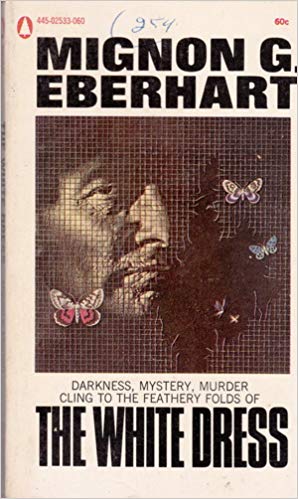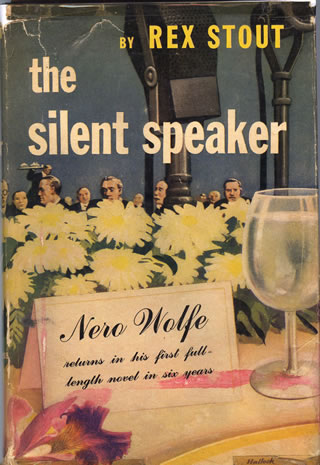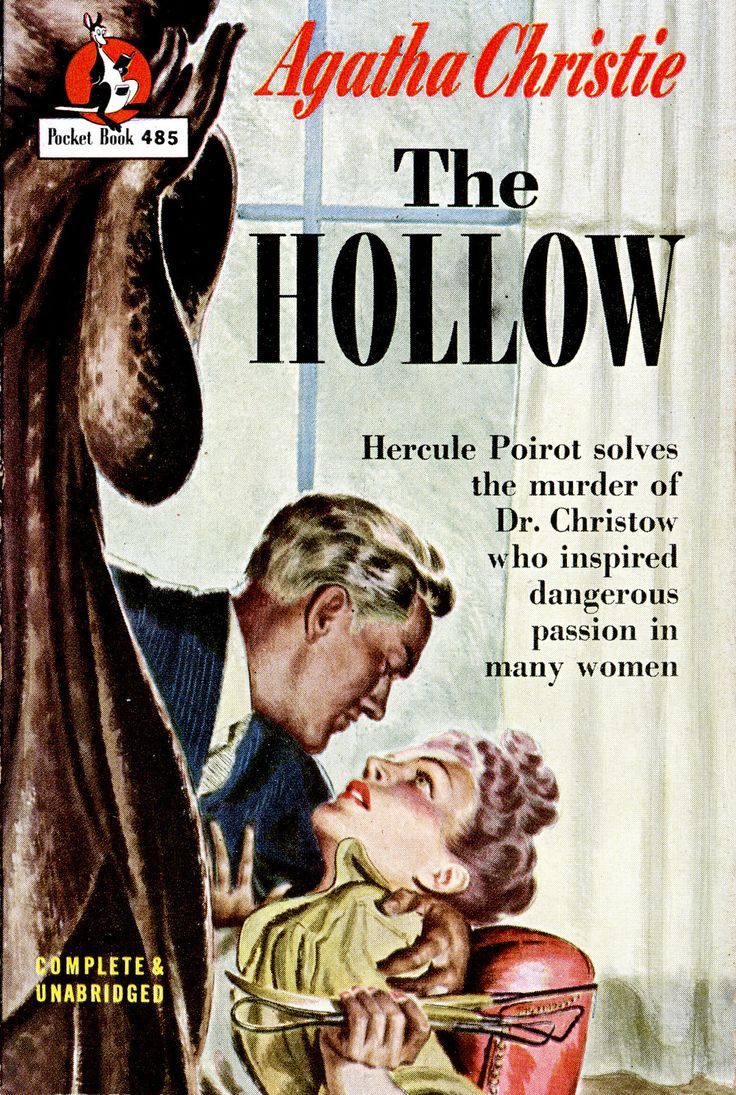I read these in a Detective Book Club edition from 1946 that combined all of them into a single volume, so I am reviewing them all together. Let’s take a look at these immediately post-World War Two mysteries.
The White Dress by Mignon G. Eberhart

Tim Wales, owner of Wales Airlines, has had a busy few months readjusting the business to peacetime conditions. It’s time for a Miami vacation! He’s accompanied by Marny Sanderson, his right-hand woman (her actual job seems to be in public relations), and Andre Durant, a friend of Tim’s wife Judith who’d been in New York City looking for a job.
Meeting them are Judith Wales, Tim’s young and beautiful second wife, and Winnie Wales, his daughter by his first wife and not that much younger than Judith. Guests at the house include the older English gentleman Charlie Ingraham, a “perennial bachelor”, and soon Commander Bill Cameron, a Navy pilot who claims to be on a mission from Winston Churchill.
Marny is a bit puzzled by this sudden vacation; Tim had mentioned it to no one until the day of departure. But he’s not the only one with secrets. Marny is surprised in her room by Cecily Durant, Andre’s never before mentioned wife. Cecily seems to think Andre is leaving her for Marny, but Marny, despite Andre being excessively affectionate for their short acquaintance, knows nothing of this.
Cecily leaves after threatening Marny, supposedly departing from the island with her husband’s shady friend Laideau. But a short while later, Cecily is found on the grounds, murdered. Whodunnit? As it happens there is one witness, a pilot who was flying over at the island at the time. He’s quite clear that it was someone wearing a white dress.
That’d be helpful, except that there was only one woman on the island wearing white that night. Marny herself! She knows she’s not the murderer, but who else could it be?
Mignon G. Eberhart (1899-1996) was a fairly prolific mystery author with over forty novels and numerous short stories to her credit. Like pretty much every female American mystery author of the period, she was called “the American Agatha Christie.” This particular novel is a one-off, rather than part of a series.
The story isn’t a “fair play” but more “damsel in distress.” We don’t get to see Marny’s intelligence or business sense in action, as she spends a lot of time being paralyzed with fear or apprehension. The bulk of investigation falls onto the police, and on Bill Cameron. To be honest, I never warmed up to Bill, who’s a bit of an ass towards Marny, but he gets the woman in the end by being the hero. The solution to the case turns out to be a fact that’s mentioned “as you know” at the end but never even hinted at before.
There are black servants in the house, but they’re relatively unimportant to the plot. On the other hand, their portrayal isn’t particularly racist either.
Content note: suicide.
Those readers who like their male leads rough around the edges, taking command and being a bit condescending towards women may enjoy this a bit more.
The Silent Speaker by Rex Stout

Rotund consulting detective Nero Wolfe and his more physically active assistant Archie Goodwin haven’t had a paying case in quite some time. Helping the government with certain activities behind the scenes during the war was patriotic, but doesn’t pay the bills. They need a lucrative payday, and soon!
Wolfe spots a golden opportunity. Cheney Boone, Director of the Bureau of Price Regulation had been beaten to death with a wrench just before he was scheduled to give a speech to a convention of the National Industrial Association. Since government regulations are roundly hated by the NIA, all two thousand attendees must be considered as having a motivation for murder, and there are a few people from the Bureau that can’t be ruled out.
The police and FBI are stymied, so Nero Wolfe manages to bluff his way into the case, being hired by the NIA. Attention soon focuses on several missing dictation cylinders that may provide a specific motivation for the murder. The speaker is silenced, but for how long?
Rex Stout (1886-1975) made his career from the Nero Wolfe books, which combined both cerebral detection and a bit of hard-boiled action. This is the eleventh novel in the series.
It’s easy to see the author’s delight in getting to write these characters again, both as friends, and as people who get on each other’s nerves.
There’s an extended section towards the end where it looks like Wolfe has given up and is faking a nervous breakdown just to buy time. The truth is a clever twist that is fully set up.
Recommended to Nero Wolfe fans, though it’s one of the few stories that is specifically tied to historic events, so can be a bit tricky for the loose continuity of the series.
The Hollow by Agatha Christie

The Hollow of the title is the country manor of the Angkatells. They’ve invited some relatives and friends up for the weekend. One of the guests is Dr. John Christow, who’s a massive jerk towards women. After running away from his first love, beautiful and volatile actress Veronica Cray, Dr. Christow married the plain and doormat-like Gerda only to discover that she doesn’t satisfy him intellectually. He’s carrying on an affair (which may or may not include sex) with sculptor Henrietta, who is also pursued by Edward, the lord of Ainswick Manor, where several of the characters spent their childhood.
Veronica reappears after fifteen years, ready to resume where she and John left off. He finally settles matters with her, and finally realizes what a cad he’s been–so it’s at that moment he’s shot dead.
Enter Hercule Poirot, who immediately notices that the murder scene feels artificial, as though it had been staged specifically to baffle him.
This is one of the more unusual Poirot novels, much more about the thoughts and feelings of the characters than about the puzzle of the murder. We spend time in the heads of multiple people, not just the heroine or the detective. In all likelihood, Christie was trying to use some of the skills she’d picked up writing her “Mary Westmacott” psychological novels.
This gives the novel a brooding, dreamlike quality that is not what mystery fans normally go for. On the other hand, this makes the ending less susceptible to spoiling than some of the other narrative tricks Christie used over the years.
The character of Gerda Christow is especially interesting here, and also frustrating. She is, admittedly, not very bright, but also seems to have some sort of problem freezing up when she has to make decisions. Her establishing moment is when Dr. Christow is late to lunch, and she has to decide whether to send the main course back to the kitchen to be kept warm (which might get her scolded for not having it ready for him) or to keep it on the table (which might get her scolded for letting it get cold.) She keeps spinning her mental wheels and ends up not doing anything. And getting scolded.
As a result, Gerda’s learned to pretend she’s even more stupid than she actually is. This gives her room to think as everyone around her assumes she doesn’t understand what they’re talking about, while she is catching at least a little. Readers can play amateur psychologist and try to figure out what diagnosis they’d give Gerda.
There’s also a striking scene where Edward realizes what his poor but proud cousin Midge goes through in a retail job; as one of the privileged, it’s never occurred to him to suspect just how bad it is for working class folk. Unfortunately, his reaction is to try to free Midge from drudgery, not reform the capitalist system that exploits many women and men just like her.
Content note: There’s casual use of the N-word, both by the uneducated and by someone who should really know better. Also, suicide.
The ending makes sense, but may be unsatisfying for many readers who would have hoped for more precise justice.
Recommended for Agatha Christie fans who are ready to try something a bit more difficult to fit into the mystery genre.

